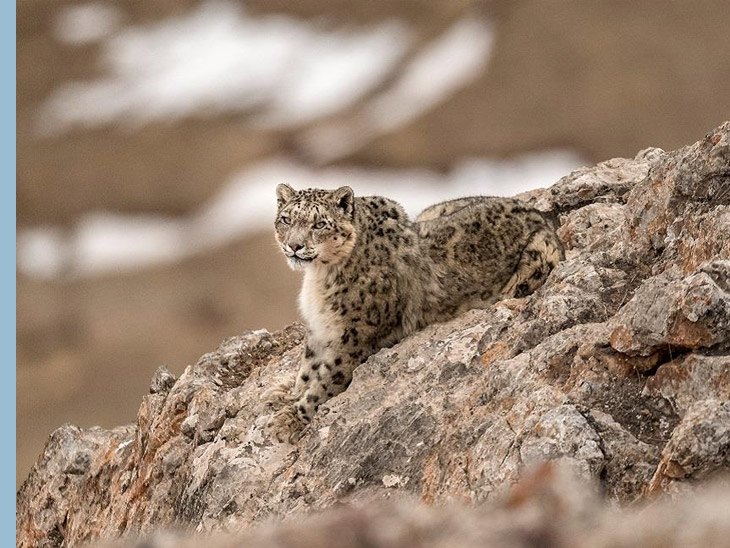THE ART OF PATIENCE
What brings together a world-renowned French photographer, an animal film director, a French travel writer and an Australian singer-songwriter in one story? A film shot in the Tibetan highlands! The French director Marie Amiguet (1986) and Vincent Munier made a documentary in the heart of this virgin and inaccessible valleys, one of the last sanctuaries of the wild world. She filmed her life companion, photographer Vincent Munier, who leads adventurer and novelist Sylvain Tesson — who greatly admires him — in his quest for the snow leopard. For several weeks, they explored these valleys to meet unique animals and try to spot the snow leopard, one of the rarest and most difficult to approach felines. Munier introduced Tesson to the delicate art of hiding, reading tracks, to decipher wild spaces, rediscover silence, observation and the patience necessary to catch a glimpse of the animals. While traveling the summits inhabited by invisible presences, the two men weave a dialogue about our place among living beings and celebrate the beauty of the world. This trip inspired Sylvain Tesson's book La Panthère des neiges, awarded the Prix Renaudot 2019. And for the first time this year, the Cannes Film Festival organized an ephemeral selection, ‘Cinema for the climate’, placing the ecological issues of our time at the center of the cinematographic debate. A perfect opportunity for director Marie Amiguet to present her documentary of the same name La Panthère des neiges, with a theme song by Nick Cave.
The Frenchman Vincent Munier, one of the most recognized wildlife photographers in the world — as I already told in one of my earlier inspiring stories — spent 10 years tracking the snow leopard, until this documentary film by himself and his life companion, Marie Amiguet, which closes this enchanted parenthesis with superb.
Their last trip to Tibet, to meet the enigmatic snow leopard on the lookout in the heart of nature with the writer Sylvain Tesson, is what Marie Amiguet and Vincent Munier offer on their experience with this film: La Panthère des neiges. The trailer about this poetic adventure looks very promising; an almost unforeseen feature film as entrusted by the two interested parties, which takes the spectators into the heart of nature and silence. This quest for the invisible was also a revelation for Sylvain Tesson. He describes it as “a return to the animal essence of man, a humility in the face of nature which will be the key for it to finally reveal itself to him.”
Because the first screening in Belgium, in December 2021, was postponed due to stricter corona measures, we went to watch their wonderful documentary at our southern neighbors, in Le Majestic in Lille.
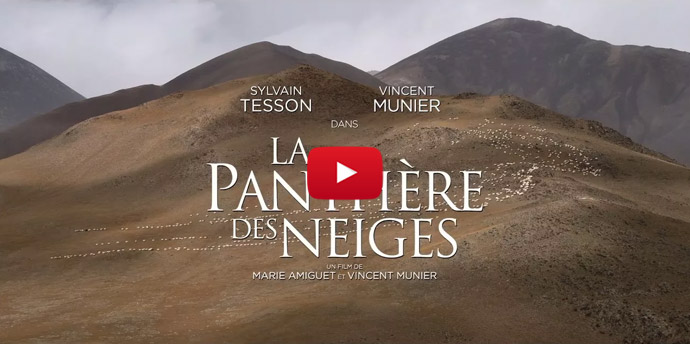
Beautiful trailer of the documentary film by Vincent Munier and Marie Amiguet, with a theme song by Nick Cave.
"The cinema cannot save the climate on its own, of course. But it is representative of a look at the way people live and the environment. And it is important to bring these testimonials to the screen. Ecology concerns living beings, but also the link between humans and what surrounds them. By adapting them into film, we project a reality that concerns us all." — Marie Amiguet
FROM CINEMATOGRAPHER TO DIRECTOR
With her title of French skate champion in 2006, Marie Amiguet proved not only that skateboarding is not just for boys, but also that she can hold her own. She was passionate about skateboarding and performing stunts for movies at the same time as she was studying biology in Montpellier. Her professional objective was oriented towards a career as an animal photographer.
If we dive into her near past, she assisted as a cinematographer in 2016 on the film LA VALLÉE DES LOUPS. In this animal documentary Jean-Michel Bertrand, a French photographer and nature filmmaker, is on the trail of wolves in the heart of the Alps. For three years, and in all weathers, the passionate wolf lover and filmmaker merged into the Alpine massifs to meet the iconic predator. The documentary recounts the adventure of this extraordinary character, between heaven and earth. Despite the snow, rain and wind, he persists and searches with obsession. His journey is punctuated by doubts and unforeseen events, but also beautiful encounters. The film is raw and shows these animals and this valley as spontaneously as possible. A magical epic in the heart of the mountains. This ‘valley of the wolves’ remained secret. The moments of quest were therefore ‘reconstructed’ from scratch but in places other than those where he camped to meet the wolf, and these so that no one from the images can find this secret valley.
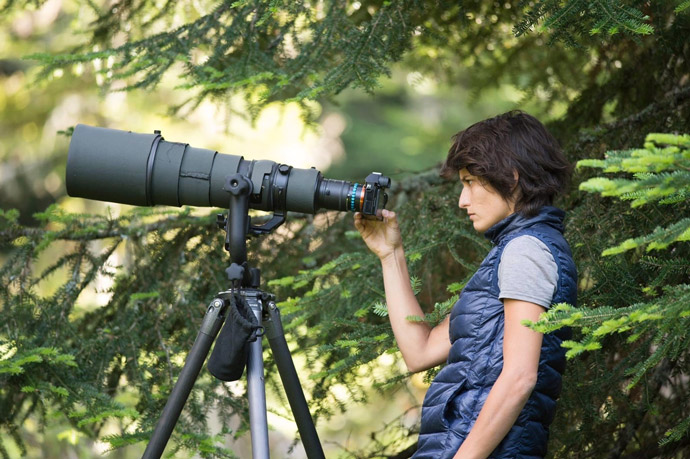
The first collaboration between Munier and Amiguet dates back to 2018 when they draw our attention to the fact that despite its reintroduction in France, the Eurasian lynx is once again threatened. Their short movie, LE SILENCE DES BÊTES, offers beautiful images of the lynx and testifies to the drama that the animal is going through in France: poaching. The movie is a rant against the slaughter of lynxes. The story of this couple, whose male is poached, modestly portrays the attacks that the species regularly undergoes in the Vosges, Jura or even the French Alps, despite its status as a protected species. Today, in France, a few hundred individuals remain. The film is both magnificent, sad and most of all necessary. The tone is serious, when a gunshot disrupts the soundtrack and we understand that one of the animals in question was killed by hunters. “Lynx mâle criblé de 120 plombs de chasse” can be read on one of the shots in the film.
The wolf, monstrous animal of myths, subject of incessant debates and countless controversies, does it really constitute a threat to the herds? With AU RETOUR DES LOUPS (2019) , Marie Amiguet posed this thorny question of the relationship that the predator has with the human species. The first question posed by author-director in Au retour des loups is that of irrational fear. Evil character of myths, incarnation of evil in monotheistic visions, the wolf was however domesticated by man in prehistory. So what happened next? Indeed, if we listen to the stories in the film, it is the raid of the 'savage' that scares with the return of the wolf. Often in the headlines of newspapers, this uncontrolled animal provokes virulent hostility as it currently does in the region where I live, which is Oudsbergen, Belgium (View some articles on this Belgian newspapers: DeMorgen and DeStandaard).
We understand throughout the documentary that solutions have been found, but which redraw our relationship to a secure world. The testimonies of Jean-Marc Landry, one of the first witnesses of the wolf's return to Switzerland, and Jean-Michel Bertrand even suggest that too often, it is the wrong questions that are asked, and therefore illusory and ineffective answers that are provided. What the documentary questions with relevance and conviction is the relationship we have grown used to maintaining with nature. The question of the wolf fits into this problematic in that the predator is an obstacle to agricultural productivism in which we have locked ourselves. Because the impact of the wolf on the herds exists, Marie Amiguet does not avoid the question. On the return of the wolves, on the other hand, discusses our relationship to predation, our knowledge of predators. The hypotheses that emerge from the documentary bring a real breath of fresh air to a perpetually stereotypical and caricatured view of the problem.
Far from the media buzz cleverly maintained around the hated animal, Au retour des loups therefore provides elements of knowledge and concrete answers that defuse the debate and rather examine the reasons for our failure to face the return of this predator.
LONELY AT A HIGH ALTITUDE, IN BITTER COLD
At the beginning of 2021, the French writer and adventurer's splendid book The Art of Patience: Seeking the Snow Leopard in Tibet was published and awarded. Sylvain Tesson didn't hesitate when Vincent Munier invited him and accepted the invitation to follow their footsteps in the middle of winter. He knew he would take part in an extreme expedition across the inhospitable, icy and high-altitude plains of the Himalayas in search of the very shy and endangered snow leopard. In a certain passage in his book he writes: “His fur looked like mother-of-pearl and had a blue sheen. That is why he was called a snow leopard, for he came as silently as snow, and retreated with muffled strides to melt with the rocks.”
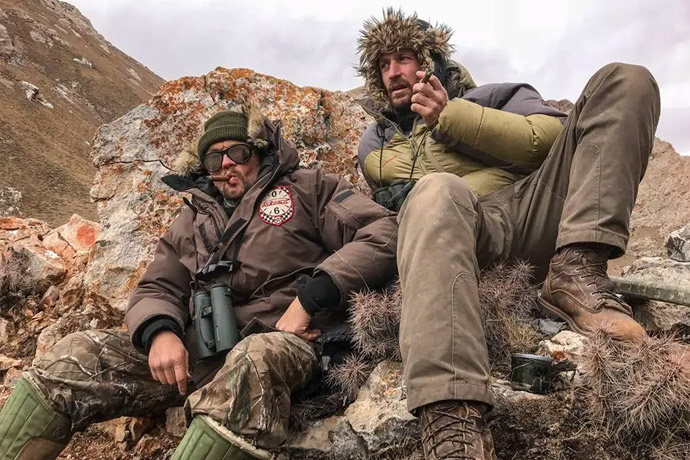
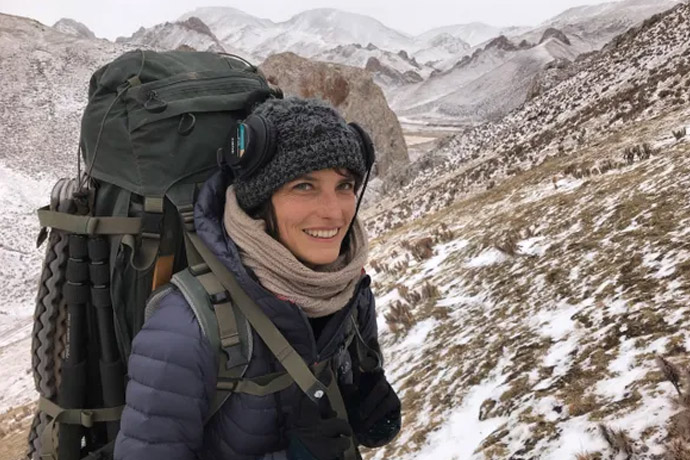
Above: Sylvain Tesson (left) and Vincent Munier smoking a Cuban Epicure No.2 cigar | Below: Documentary director Marie Amiguet (Photos: Paprika Films/Kobalann Production).
After having closed the books of Peter Matthiessen and, later, Paolo Cognetti, there remained a strange feeling, a mixture of frustration and sadness. The two writers had gone to Tibet, fifty years apart, in search of the snow leopard. They have never seen it. Of course, the lesson was beautiful: no matter the destination, only the path counts. But was the snow leopard, a victim of the madness of men, always of this world? Sylvain Tesson's book brings the long-awaited answer: yes, she is here and her ancestors may have watched Matthiessen and Cognetti, stoic, camouflaged on their granite pedestal.
"The film industry must lead a collective change of consciousness to achieve its environmental objectives." — Marie Amiguet
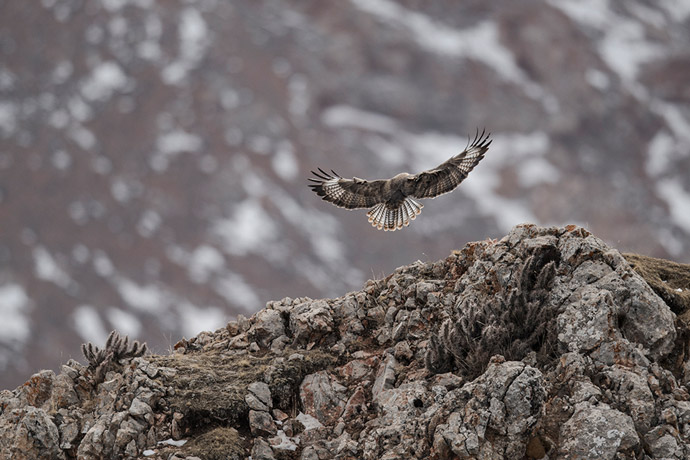
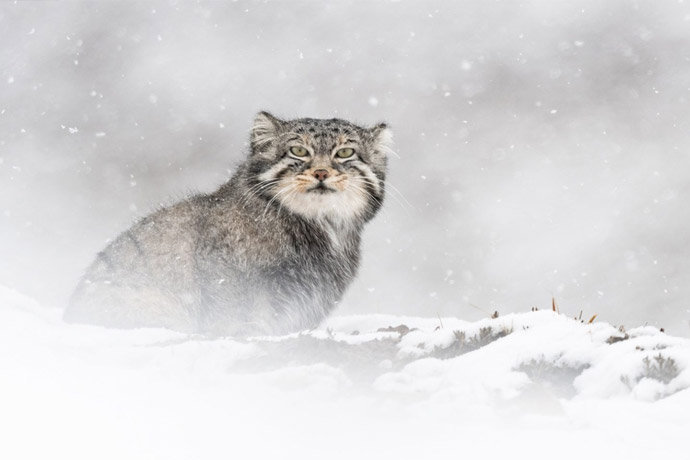
Below: A solitary Pallas's cat, also known as the manul. Pallas’s cat is similar in size to a domestic cat but it looks much bigger because of its stocky build and its long, thick coat, which helps protect it in its frosty habitat. This small, well-furred wild cat is well camouflaged and adapted to the cold climate in its native range. Their fur changes color depending on the season, in winter being a frosted gray and in spring a gray/fox-red.
"A shaggy head, syringe canines and yellow eyes correct his plush cuteness with demonic glow. Pallas’s cat seems to resent evolution for giving him such a dose of aggression in such a charming body." — Sylvain Tesson
The film crew was reduced to four people, and that was already a lot. Perhaps even too much to hope to be discreet on the bare peaks of Tibet. The team consisted of the initiator Vincent Munier, accompanied by Marie Amiguet, fiancée of the photographer — and I quote Tesson: “a girl with a feline body who makes animal documentaries and who loved living in untouched nature” — and Léo-Pol Jacquot, Munier's computer scientist and philosopher aide-de-camp. And Sylvain Tesson of course. He himself did not really believe in his abilities. “I, who loved to run the roads and platforms, would I be able to spend hours motionless and silent?” Where Cognetti whined a little too emphatically about his own physical discomfort, Tesson brings much more depth. He's a geographer, the Himalayas are a playground for him. His descriptions are peerless, his musings penetrating. The book has since become a huge literary success, what I can attest.
Vincent Munier prances on the peaks of Tibet with a forty kilo backpack. Sylvain Tesson, his back in mush, carries a bag full of memories. The gyrovague writer — an itinerant and solitary Christian monk who wanders and passes from monastery to monastery, without being a member of any —, with a brilliant conversation, runs like a man in a hurry after stillness and silence. He recognizes in Vincent Munier a master, a man in whom “the love of animals had abolished all vanity”.
In the heart of the Tibetan highlands, the photographer Vincent Munier leads Sylvain Tesson in his quest for the snow leopard. He introduces him to the delicate art of hiding, reading tracks and the patience necessary to catch a glimpse of the animals. While traveling the summits inhabited by invisible presences, the two men weave a dialogue about our place among living beings and celebrate the beauty of the world.
"I don't believe I'm an artist, I'm a witness to what's going on. Art is in nature. I'm here; I have a look. I look a little different, but art is everywhere." — Vincent Munier
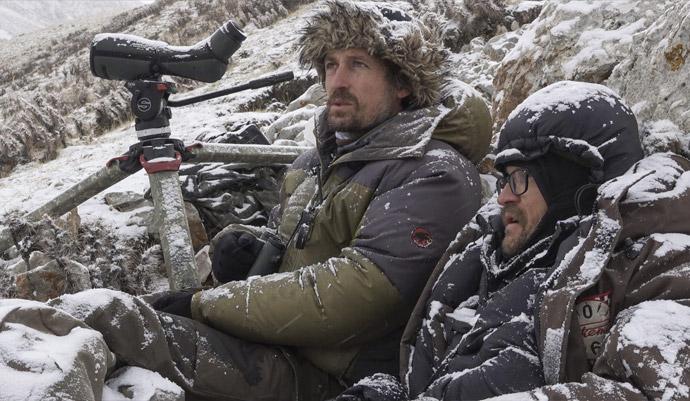
LA PANTHÈRE DES NEIGES
La Panthère des neiges is the title of Marie Amiguet's documentary film. Its attentive and inspired camera follows the journey of famous wildlife photographer Vincent Munier in the footsteps of the iconic animal. In his footsteps, the traveling writer Sylvain Tesson. The documentary has become a story of a meeting between two very different ways of crossing the world.
Vincent Munier and Marie Amiguet did everything in a traditional way, with as little travel as possible. All together, they made eight trips for making the documentary: six solo by Munier, who filmed most of the animal images before they embarked on the making of this film, then two trips with Sylvain Tesson, especially focused on the meeting of the two characters and the quest for the snow leopard.
For their actions to shoot the film, they only had tiny, one-kilo handheld cameras. Vincent Munier had his cameras and his lenses. All that remained were the binoculars and the backpack and that's how they managed it, going from camp to camp with their tents. It was very minimalist as a way of filming and making a documentary. But Amiguet doesn't know any other, and it is the one that is most suitable for wildlife filming in the wild. They really needed lightness in order to be able to move easily and constantly adapt to what is happening in the environment. With 15-kilo cameras, rails and a full film crew, it just doesn't work.
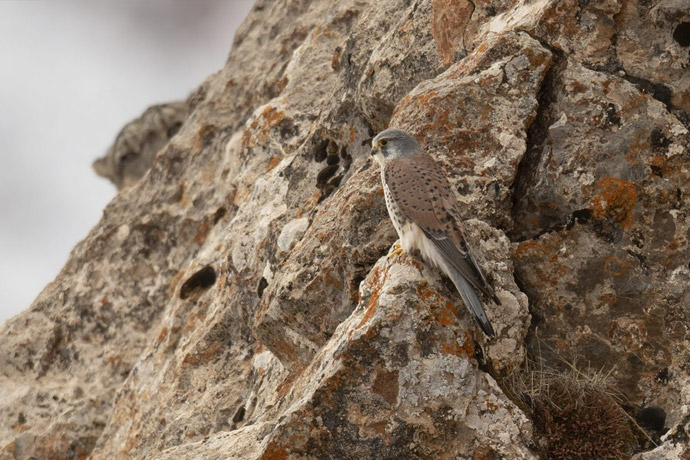
Camouflaged in its stone environment, the snow leopard almost escaped the photographer's gaze.
A passage in Sylvain Tesson's book beautifully describes the photo above as follows: ‘Vincent Munier showed the children a paper printout of a photo he had taken a year ago. In the foreground, a grey-brown falcon sits on a lichen-covered boulder. In the background, a little to the left, just above the contours of the limestone rock, invisible to an unsuspecting glance, the eyes of a snow leopard stare at the photographer. The animal's head coincides with the rock and it takes a while for the eye to notice it. Munier had focused his camera on the bird's feathers and completely overlooked the snow leopard watching him.
It wasn't until he looked at his photos two months later that he noticed him. He, the unerring naturalist, was well versed in it. […] Our Tibetan friends were not fooled. Their fingers immediately pointed to him. “Saâ!”, they shouted (Editor's note: Tibetan for snow leopard). Not that life in the mountains had sharpened their vision, but their child's eye was not led to the certainty of the directly observable. They just knew the edges of reality.’
THEME SONG: WE ARE NOT ALONE
Having scarcely committed themselves to work on film and TV these last few years, long-time collaborators and experienced composers Nick Cave and Warren Ellis have unveiled their latest joint work for the big screen in the form of the original soundtrack for new French documentary La Panthère des neiges.
"There is something about the heart of this film that draws you in. I realised after a day, that I wanted to do whatever it took to compose an entire original score. The film deserved to have its own musical voice. I booked five days and asked Nick if he could come in for a day to write a theme song and play some piano. He saw the film and stayed for four days. In the end we made what I think is one of the most beautiful films we have ever worked on. One of my favourite experiences ever working on a project. The stars are the animals in all their wild glory, as we have never seen them before, and man in reverence and wonder." — Warren Ellis
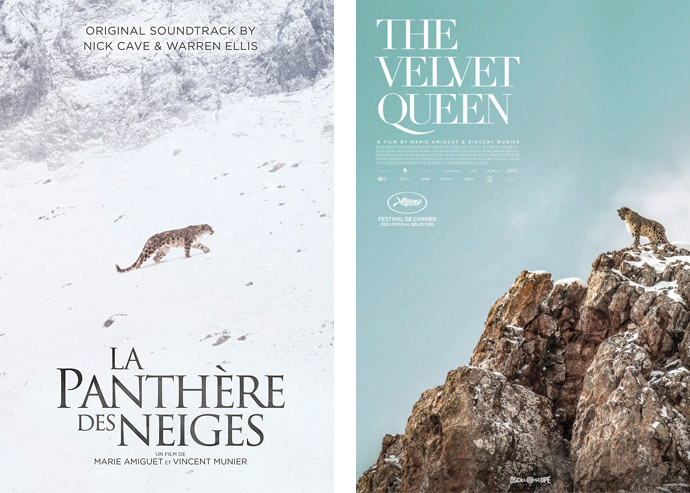
They’ve just shared ‘We Are Not Alone’, which is an actual song, not just an instrumental film-score piece. It is a bit of a lullaby, and it’s got Nick Cave singing softly about the majesty of nature. The tracks title may or may not have come from ‘Galleon Ship’, a song from Cave and the Bad Seeds’ 2019 album. While Cave and Ellis' soundtrack retains the French title, the film is being released in the U.S. under the title ‘The Velvet Queen’. The soundtrack will be out 12/23.
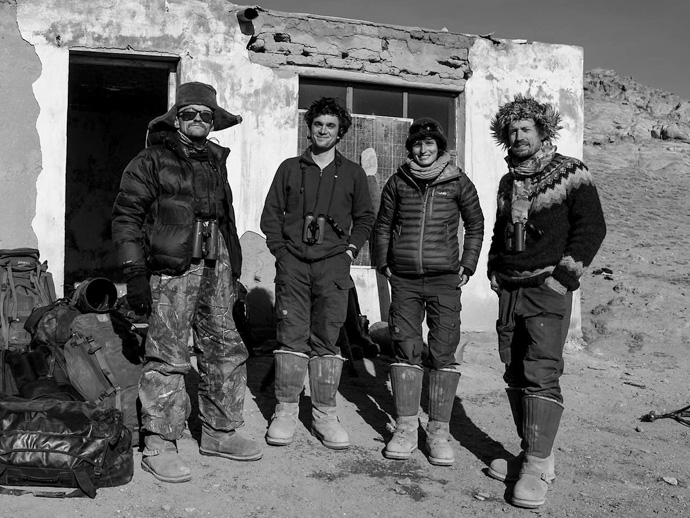
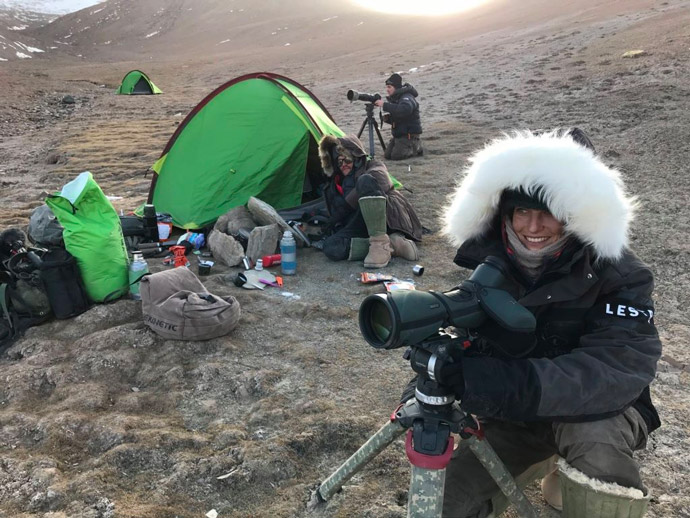
Sylvain Tesson, Léo-Pol, Marie Amiguet and Vincent Munier on the camp. Sylvain: “We are awaiting the visit of the animals, we can only hope that they are not difficult ...”
"You try to portray your dreams […] A beautiful image is a transmission of an emotion." — Vincent Munier
All images courtesy of the artist. Photos © Vincent Munier and Paprika Films/Kobalann Production.
More story related movies/interviews:
Related stories in Woodland Magazine:
Sources:
